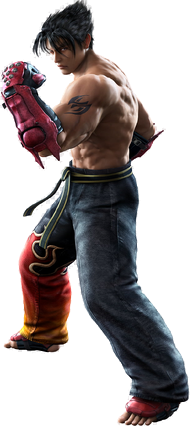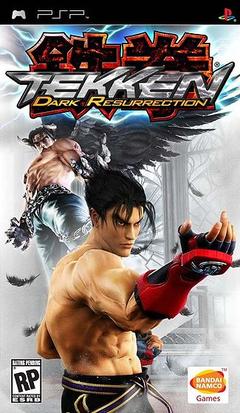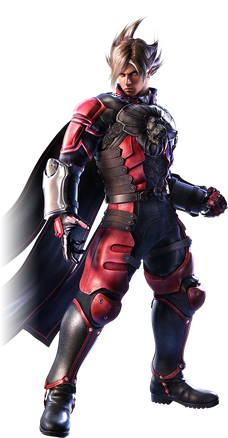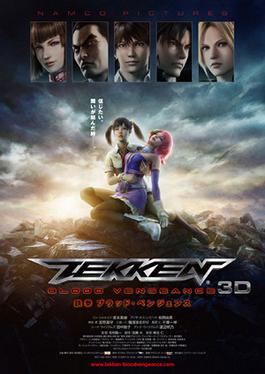Tekken is a Japanese media franchise centered on a series of fighting games developed and published by Bandai Namco Entertainment. The franchise also includes film and print adaptations.

Tekken 4 (鉄拳4) is a 2001 fighting game developed and published by Namco for arcades. It was developed for Namco's System 246 hardware and then ported to the PlayStation 2 home console in 2002. It is the fourth main installment in the Tekken series as the sequel to Tekken 3 (1997), and the fifth overall following the non-canon title Tekken Tag Tournament (1999). The game harbored many gameplay revisions, such as the series-unique ability for the player to move about before the round begins and the introduction of walled stages.

Tekken 3 (鉄拳3) is a 1997 fighting video game developed and published by Namco. It is the third installment in the Tekken series and the first game built on the Namco System 12 arcade hardware. Plotwise, the game takes place twenty years after Tekken 2 (1995) and features a largely new cast of characters, including the debut of several now-staple characters such as Jin Kazama, Ling Xiaoyu and Bryan Fury, and adds sidestepping ability to every character in-game. Tekken 3 was ported to the PlayStation in 1998 with additional content, including a beat 'em up mode called Tekken Force.

Tekken Tag Tournament is a 1999 fighting game developed and published by Namco for arcades. It is a spin-off the Tekken series. Not canon to the main storyline, Tekken Tag Tournament features nearly all the characters in the previous Tekken games and introduces a two-on-two 'tag team' battle mechanic. It was released as an arcade game, before becoming a North American and European launch title for the PlayStation 2 in 2000. The arcade version ran on the same Namco System 12 board with a 32-bit engine as Tekken 3, while the ported home console version received upgraded graphics.

Tekken 5 (鉄拳5) is a 2004 fighting game developed and published by Namco for arcades, before being ported to the PlayStation 2 in 2005. It is the fifth main game in the Tekken series, marking the tenth anniversary of the series. The game is set shortly after the events of Tekken 4 featuring a new Antagonist named Jinpachi Mishima taking over the Mishima Zaibatsu while a sidestory focuses on the protagonist Jin Kazama as he faces several enemies from the G Corporation. The home version also contains a collector's edition of sorts, as it includes the arcade versions of Tekken, Tekken 2, Tekken 3, and StarBlade.

Jin Kazama is a fictional character and the protagonist of Bandai Namco's Tekken series. Introduced in the 1997 game Tekken 3, he has been the central character of the series from that game onwards. Trained by his grandfather Heihachi Mishima, Jin wishes to avenge the apparent death of his mother, Jun Kazama, at the hands of Ogre. However, Heihachi betrays Jin to awaken a genetic abnormality within the latter's body known as the Devil Gene, leading Jin to seek revenge against his grandfather in later installments.

Heihachi Mishima is a fictional character and one of the main antagonists of Bandai Namco's Tekken series. Introduced as a boss character in the first Tekken game from 1994, Heihachi is depicted as the abusive father of Kazuya Mishima and the CEO of a military firm known as the Mishima Zaibatsu, which was founded by his father, Jinpachi Mishima. Heihachi has served as the protagonist of Tekken 2 and Tekken 7, as well as a boss character in several other installments of the series. As one of the main characters, he is one of the four characters to be playable in all eight main instalments.

Kazuya Mishima is a fictional character and one of the main antagonists of Bandai Namco's Tekken series. Debuting as the protagonist of the original game, Kazuya has since become one of the series' most prominent villains after serving as the penultimate boss of Tekken 2. The son of a wealthy zaibatsu CEO named Heihachi Mishima, Kazuya seeks revenge against his father for throwing him off a cliff years earlier. Kazuya becomes corrupted in later games, seeking to obtain more power and eventually coming into conflict with his own son, Jin Kazama. Kazuya Mishima possesses the Devil Gene, a demonic mutation, which he inherited from his late mother, Kazumi Mishima, which can transform him into a demonic version of himself known as Devil Kazuya. Devil Kazuya has often appeared as a separate character in older installments prior to becoming part of Kazuya's moveset in Tekken Tag Tournament 2 and later games. Kazuya Mishima is also present in related series media and other games.

Tekken 6 is a 2007 fighting game developed and published by Bandai Namco Games. It is the sixth main and seventh overall installment in the Tekken franchise. It was released on arcades in November 2007 as the first game running on the PlayStation 3-based System 357 arcade board. A year later, the game received an update, subtitled Bloodline Rebellion; both versions also saw a limited release in North America. A home version based on the update was released for the PlayStation 3 and Xbox 360 in October 2009; this was the first time a main installment was produced for a non-Sony console. A port to the PlayStation Portable was also released shortly after.

Tekken: The Motion Picture is an anime adaptation of the Tekken fighting video game series by Namco. Produced by ASCII Corporation and Sony Music Entertainment Japan and animated by Studio Deen, it was originally released in Japan as a two-episode OVA in 1998, and as a full-length feature for Western releases. It was one of the first original video animations to use digital ink and paint.

Tekken 5: Dark Resurrection is a 2005 fighting game and a standalone update to the PlayStation 2 game Tekken 5. The arcade version was released in Japan in December 2005 and later worldwide in February of 2006, while the PSP version was released later that year in July 2006. The game was also released as a downloadable game on the PlayStation 3 via the PlayStation Network online service in Japan in 2006 and the rest of the world in 2007. A sequel, Tekken 6 was released in 2007.

Tekken (鉄拳) is a 1994 fighting game developed and published by Namco. It was originally released on arcades, then ported to the PlayStation home console in 1995. One of the earliest 3D polygon-based games of the genre, Tekken was Namco's answer to Virtua Fighter and was designed by Seiichi Ishii, who himself was also Virtua Fighter's designer when he worked at Sega previously. The game was developed on the purpose-built low-cost System 11 board, based on PlayStation hardware.

Tekken is a 2009 American science fiction martial arts film directed by Dwight Little from a screenplay by Alan B. McElroy, loosely based on the video game series of the same name published by Namco Bandai Games. The film stars Jon Foo, Kelly Overton, Cary-Hiroyuki Tagawa, Ian Anthony Dale, Cung Le, Darrin Dewitt Henson, Candice Hillebrand, and Luke Goss. The plot follows Jin Kazama in his attempts to enter the Iron Fist Tournament in order to avenge the loss of his mother, Jun Kazama, by confronting the forces of the city that are also holding the competition.

Bandai Namco Entertainment'sTekken media franchise is known for its diverse cast of characters hailing from various nationalities, all coming together to compete in the King of Iron Fist tournament. In addition to the human characters, Tekken also features non-human characters for comic relief, such as the bear Kuma, his love interest Panda, the boxing kangaroo Roger, and the dinosaur Alex. Certain characters like Jin Kazama, Kazuya Mishima, Lee Chaolan, and Jun Kazama have their own alternative versions. Each character has their own goals for participating in the tournament.

Lars Alexandersson is a character from the Tekken fighting game franchise by Bandai Namco Entertainment. First introduced in the 2008 arcade game update Tekken 6: Bloodline Rebellion, he serves as the main protagonist of the Tekken 6 story mode.

Tekken Tag Tournament 2 is a 2011 fighting game, the eighth installment in the Tekken fighting game series and the sequel to Tekken Tag Tournament. It was released for the arcades in September 2011. It received an update, subtitled Unlimited, in March 2012. A console version based on the update was released for PlayStation 3 and Xbox 360 in September 2012, prior to the update. It was ported to the Wii U as one of the system's launch titles in November 2012, subtitled Wii U Edition.

Tekken: Blood Vengeance is a 2011 Japanese animated science fiction martial arts film directed by Yōichi Mōri from a screenplay by Dai Satō, based on the video game series Tekken published by Namco Bandai Games. The film places focus on the young martial artist Ling Xiaoyu, who investigates experiments involving a supernatural curse related with the Mishima family, while befriending a robot named Alisa Bosconovitch. The two meet the test subject Shin Kamiya, who is being sought by his former friend Jin Kazama and his father Kazuya Mishima, but is also being used by Heihachi Mishima to set a new family fight.

Tekken Revolution was a free-to-play fighting video game developed and published by Namco Bandai Games. It was released on the PlayStation 3 via the PlayStation Store in June 2013. It is the first game in the Tekken franchise to be made free-to-play and the first to be released exclusively in digital format. It is no longer available in Europe as of 2016.

Tekken 7 is a 2015 fighting game developed and published by Bandai Namco Entertainment. It is the seventh main and ninth overall installment in the Tekken series, and is the first in that series to be released for PC. Tekken 7 was released to arcades in March 2015. An updated arcade version, Tekken 7: Fated Retribution, was released in July 2016, and features expanded content including new stages, costumes, items and characters. The home versions released for PlayStation 4, Windows, and Xbox One in June 2017 were based on Fated Retribution.

Tekken 8 is a 2024 fighting game developed by Bandai Namco Studios and Arika and published by Bandai Namco Entertainment. It is the eighth canon release in the Tekken series and the first one to debut on home systems instead of arcades. Game tests were held starting in July 2023 before the final game was released for the PlayStation 5, Windows, and Xbox Series X/S on January 26, 2024.




















